Chelmsford, Essex
Up to 1834
A parish workhouse existed on New Street in Chelmsford from around 1716. It is said to have been a three-storey building with 14 rooms. The workhouse was described in An Account of Several Workhouses..., in a report dated December, 1722.
THE Parish chose twelve Trustees to direct the Work and they provided Money to go on with it : They borrowed 300l, upon Interest, besides what they gathered from the Rates ; it was about six Months before it was ready to receive the People The whole Charge was about 600l. and in a Year and a half's time, by lesser Rates than they had paid before, they discharged all the Workmen, and the Money borrowed upon Interest : We paid 3s. 6d. in the Pound, but paid only 2.s. 6d. all the Time of the Building ; and since it is finished, we have reduced it to 1s. in the Pound for the whole Year, including the Churchwarden's Rate ; for we have no Church Lands belonging to us.
THIS House was built in 1716, and I may aver, that the Parish has saved, by having a Workhouse, between 1000 or 1100l. For the People of the Parish have been sorely afflicted with the Small-Pox, and Fevers, and Agues ; and because they would not come to the House, they have made shift with a Shilling, when four before would not content them; and they were wont to be always troubling the Overseers for Money, tho' never satisfied whatever they gave them ; but now the Overseers Office is the easiest Office in the Parish : We pay no Rents as we used to do, for we paid as many Rents formerly, as would pay the Interest of the Money that built the House.
IF a Person that is industrious falls sick, or his Family, we do not presently hurry him into the Workhouse, but give him now and then a Shilling for present Assistance: And if those that do come in, have any Goods, they bring them in with them.
ELEVEN Persons had the Small-Pox in the House, and it cost the Parish not one Shilling for nursing them, nor any Charge for an Apothecary ; thank G0D then all did well with the Kitchen Physick, which saved the Parish Abundance of Money, which must have been expended, had they been nursed abroad as they used to be.
THUS far you have an Account of the good Effects the Parish has received by Building the Workhouse : I shall now inform you how the Poor are managed.
THE ancient People are treated according to their Age, without Compulsion: But the lusty and strong are tasked according to their several Abilities, some to earn 5d. some 4d. some 3d. and the Children some 1d. some 2d. a Day. They have always a Breakfast to go on with their Day's Work; and if they be not forward in the Forenoon, they have neither Dinner nor Supper till they have done.
THEY have the best of Beef and good Pudding three times a Week, Sundays, Tuesdays, and Thursdays : They are allowed Beer, two Bushels of Malt to the Hogshead, and nine Gallons to the Bushel : They have all a clean Shift every Week, and Care is taken that they be washed, and their Heads comb'd : They have two Bushels of Meal every Week, and bake it as it comes from the Mill : They have good Cheese, and good Butter, and all other Necessaries for House-keeping. There are four Overseers, and every one accounts in his Quarter to buy such things as are wanted ; and the Master keeps the general Accounts for the whole Parish ; so that every Parishioner may see what his Money is laid out for. I should have informed you, that they make Broth from the Meat for the next Morning, and other Mornings Milk Porridge from the best of Milk.
0ur whole Charge for the Year is about 190l. but has been 500l. and more.
P.S. At the Season for picking Hops, the whole Family have been employ'd that Way, and earned not a little by their Labour.
According to the same publication, parish workhouses existed at Baddow and at Springfield. Good Easter had a workhouse from around 1715 and Great Waltham from 1718 (Hitchcock, 1985).
A parliamentary report of 1777 recorded parish workhouses in operation at Great Baddow (with accommodation for up to 20 inmates), Buttsbury (10), Chelmsford (100), Danbury (18), Fryerning (20), South Hanningfield (9), Roxwell (20), Springfield (35), Stock (10), Great Waltham (100), Little Waltham (20), and Writtle (100).
A new workhouse was built in Great Baddow in 1790 on Vicarage Lane, formerly known as Workhouse Lane. The parish also encouraged people to stay out of the workhouse — in 1800, 27 spinning-wheels were bought and loaned to poor families so that they could generate an income for themselves.
A house on Danbury's main street, formerly known as The Chantry House, is said to have been used as the parish workhouse in the eighteenth century.
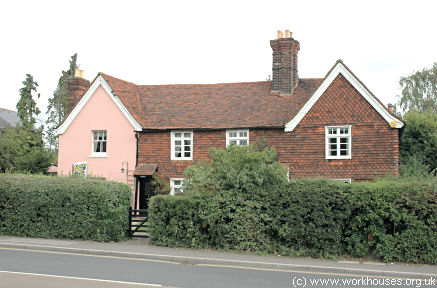
Danbury former workhouse, 2006.
© Peter Higginbotham.
Writtle's workhouse was built in 1717 at the east end of what is now Bridge Street, formerly Workhouse Lane. In September of that year, John and Dorothy Green were appointed governor and governess with "a book to be kept of all money received and expended, with the same salary as the work house in Chelmsford." In 1844, the site was sold by auction at the Cock and Bell in Writtle, when Jospeh Hardcastle of Writtle Brewery bought the buildings which became part of his expanding brewery.
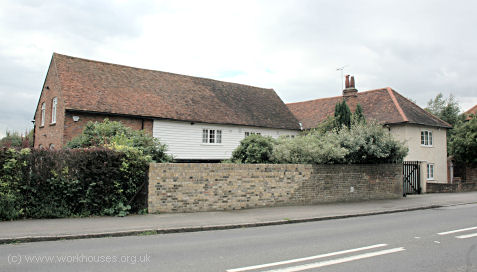
Writtle former workhouse, 2006.
© Peter Higginbotham.
The joint parishes of Stock and Buttsbury had a workhouse at Stock on what is now Common Lane, formerly Workhouse Lane.
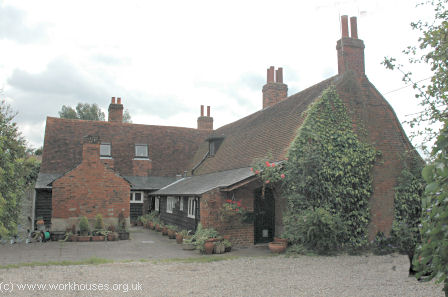
Former Stock and Buttsbury workhouse, 2006.
© Peter Higginbotham.
Although not listed in the 1777 survey, Ingatestone had a parish workhouse in a row of cottages on the High Street. In 1784, the parish paid Thomas Caton the sum of 2s.4d. per inmate per week to farm its poor. The workhouse remained in use until 1835 at which time its inmates comprised seven men and one woman, all old and infirm.
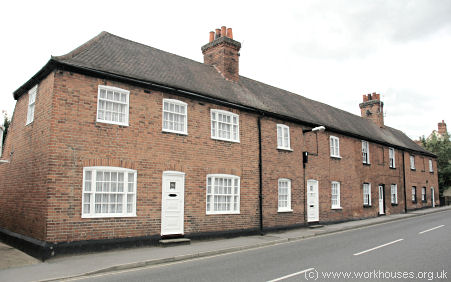
Former Ingatestone workhouse, 2006.
© Peter Higginbotham.
Boreham had a workhouse from as early as 1714, possibly on the site now occupied by Avery's Rest Home. Another workhouse was located on Waltham Road in premises later know as Henning Hall.
Freyerning had a workhouse for a period in a property known as Brook House, formerly an inn variously called The Three Nuns, The Ship, and the Coach and Horses.
East Hanningfield's parish workhouse stood on Old Church Road, at the junction with Back Lane. In around 1838, after the opening of the new union workhouse in Chelmsford, the premises were put to use as a Dame School. The censuses for 1841-61 record the schoolmistress as being Bathsheba Cheek. In 1865, the property was demolished and replaced by a new National School building, now a private residence known as Old School House.
After 1834
Chelmsford Poor Law Union was officially formed on 10th August 1835. Its operation was overseen by an elected Board of Guardians, 32 in number, representing its 26 constituent parishes as listed below (figures in brackets indicate numbers of Guardians if more than one):
County of Essex: Great Baddow, Little Baddow, Boreham, Broomfield, Butsbury, Chelmsford (4), Chignall St James, Chignall Smealy, Danbury, Good Easter, Fryerning, East Hanningfield, South Hanningfield, West Hanningfield, Ingatestone, Margaretting, Mashbury, Pleshey, Roxwell, Sandon, Springfield (2), Stock, Great Waltham (2), Little Waltham, Widford, Writtle (2).
At the first meeting of the Board of Guardians, held on 15th August 1835 at the Black Boy Inn, it was agreed that the parishes of Great Leighs, Little Leighs, Rettendon, Runwell and Woodham Ferris [Woodham Ferrers] would be added to the union. The population falling within the enlarged union at the 1831 census had been 26,455 with parishes ranging in size from Chignall Smealey (population 75) to Chelmsford itself (5,435). The average annual poor-rate expenditure for the period 1832-35 had been ££19,286 or 14s.7d. per head of the population.
The new Chelmsford Union workhouse was erected in 1837 at the west side of Wood Street, on a site known as Chelmsford Barracks Ground. It was designed by William Thorold who was also the architect of the Rochford Union workhouse as well as several in Norfolk. His design for Chelmsford was based on the model "square" plan devised by Sampson Kempthorne for the Poor Law Commissioners in 1835. The new workhouse could accommodate 400 and cost £5,650 to construct. The layout of the building is shown on the 1874 map below.
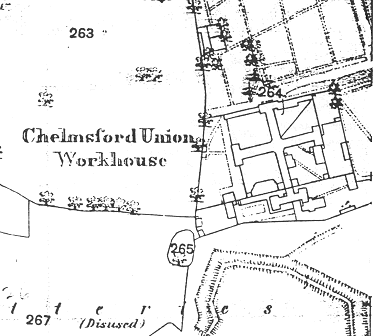
Chelmsford site, 1874.
An new infectious ward was added in 1877.
In 1886, the old workhouse was almost completely destroyed by a fire. A new pavilion-plan building, designed by Fred Chancellor, was erected on the existing site and opened in 1889. It incorporated a few surviving parts of the old workhouse. The new workhouse could accommodate 435 inmates and cost £16,000. The layout of the replacement building is shown on the OS map from 1921.
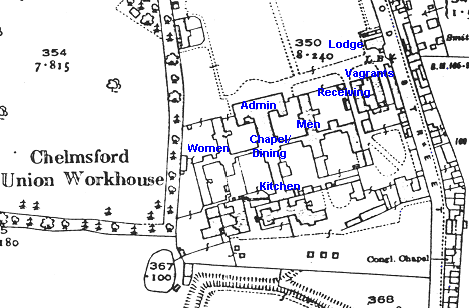
Chelmsford site, 1912.
The entrance to the site was at the north where the porter's lodge was situated.
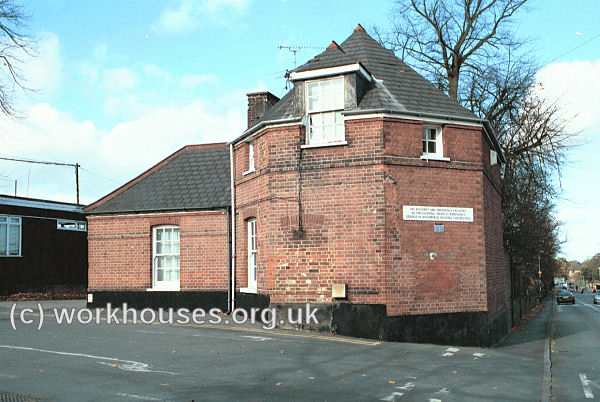
Chelmsford entrance lodge from the south, 2000.
© Peter Higginbotham.
To the south of the lodge were a receiving ward block and vagrants' wards.
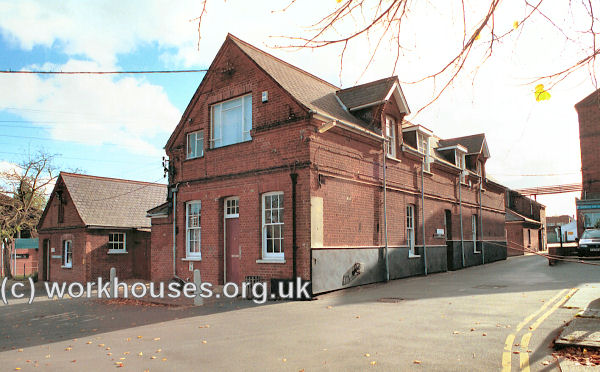
Chelmsford receiving block with female vagrants' ward behind from north west, 2000.
© Peter Higginbotham.
The administrative block of 1889 lay at the north of the site.
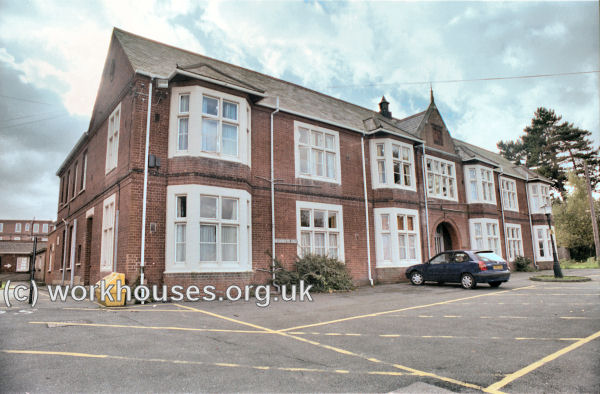
Chelmsford administration block from the north-east, 2000.
© Peter Higginbotham.
To its south, at the centre of the workhouse, were a dining-hall with chapel above. Male accommodation blocks were at the east, and female at the west.
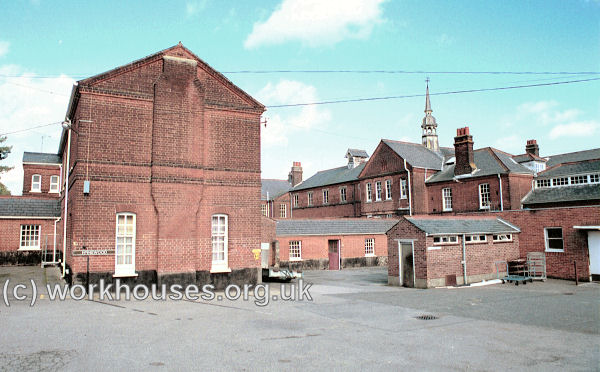
Chelmsford able-bodied women's ward (left) and dining-hall/chapel (right), 2000.
© Peter Higginbotham.
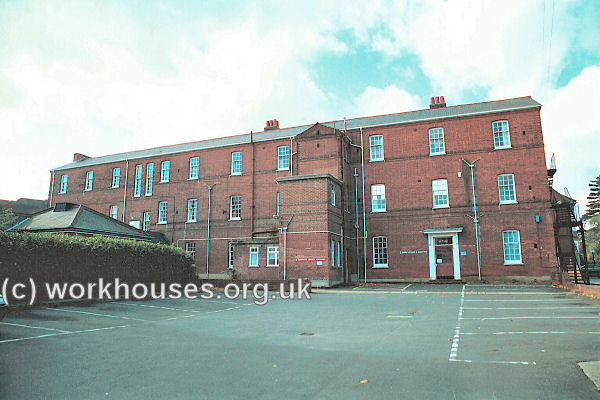
Chelmsford male ward from the east, 2000.
© Peter Higginbotham.
One survival from the 1837 building was the kitchen range, originally the south range of the old workhouse.
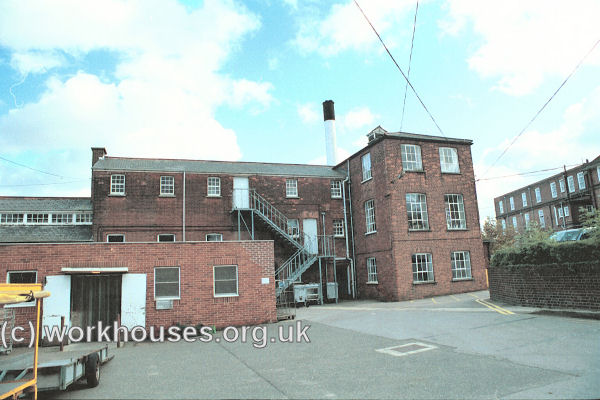
Chelmsford kitchen range from the west, 2000.
© Peter Higginbotham.
The former workhouse later became St John's Hospital. Most of the later infirmary buildings were demolished in 2010 to make way for a housing development, but the original workhouse were refurbished for residential use.
Chelmsford Union Children's Homes
The Chelmsford Guardian's opened two homes for its pauper children, one for boys at Writtle, and one for Girls on Baddow Road, Great Baddow.
The Writtle home for 25 boys was opened in September 1905 in a house known as Greenbourne at the south-west corner of Writtle Green, a former school for young ladies.
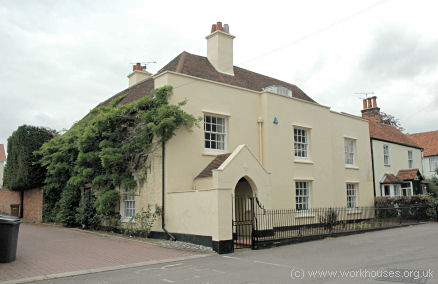
Writtle boys' home, 2006.
© Peter Higginbotham.
According to a former resident at Greenbourne in the 1940s, the house had a large dining-room at the back, with a sitting-room to the front right-hand side which had a stage, where some musical instruments were kept including a xylophone, one-string fiddles, and a wire zither. The home had a band which played at venues around Chelmsford including Chelmsford Cathedral. Some of the boys sang in the church choir. The upper floor of the house had two dormitories. Every morning before breakfast, the boys made their beds and tidied the dormitories. There was a fire-chute in the window of the dormitory, to be thrown out if a fire started. The boys used to play football and cricket on the village green and had occasional trips to the seaside or to watch Chelmsford play football on a Saturday. Part of the garden was put aside for vegetables and with a large number of marrows being produced, resulting in weeks of marrow for dinner, marrow-jam for tea, and marrows for dessert.
The home continued in use until the 1970s, in its later years taking both boys and girls, including some seriously disturbed children — a boy from the home set fire to the parish church in 1974. In the early 1980s Greenbourne became a private house again, and the large extension at the back was pulled down. The large garden was sold off and houses built on the land, the road being called Comyns Place.
The union's home at Great Baddow opened in 1908 and could accommodate 22 girls.
Staff
- Chelmsford workhouse — 1881 Census
- Some Staff of Writtle Boys' Home:
- 1908-10 Superintendent: Charles Cooke
- 1912-c.1915 Foster Father: Henry Martin; Foster Mother Mrs. Martin
- c.1915-1929 Foster Father: Stanley George Martin; Foster Mother Mrs. Martin
- 1933 Master: William Swain
- 1937 Master: Harry Theodore Pummell
- 1955 House Father: John Arthur Chegwin
Inmates
Records
Note: many repositories impose a closure period of up to 100 years for records identifying individuals. Before travelling a long distance, always check that the records you want to consult will be available.
- Essex Record Office, Wharf Road Chelmsford CM2 6YT. Holdings include: Guardians' minutes (1835-1930); Ledgers (1835-1929); Admissions and discharges (1883-88, 1891-4, 1897-8, 1926-9); Indoor relief books (1886-1931); etc.
Bibliography
- Hitchcock, T.V. (1985) The English workhouse: a study in institutional poor relief in selected counties. l695-l750. (DPhil thesis. University of Oxford.)
Links
- None.
Acknowledgment
- Thanks to Writtle Archives for information on Writtle.
Unless otherwise indicated, this page () is copyright Peter Higginbotham. Contents may not be reproduced without permission.


